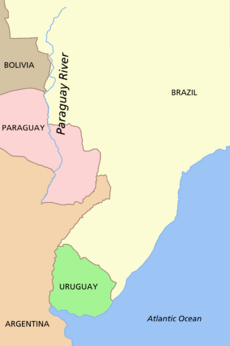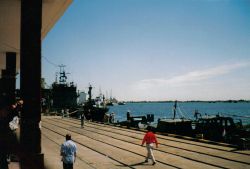Paraguay River
The River Paraguay (Río Paraguay in Spanish, Rio Paraguai in Portuguese, and meaning “big mirror of waters” in native Guaraní language) is a major river in south central South America, running through Brazil and Paraguay and running close to the border between Brazil and Bolivia as well as being the border between Paraguay and Argentina. It runs over a course of approximately 2,549 kilometers (1,584 miles) from its headwaters in the Brazilian state of Mato Grosso to its confluence with the Paraná River north of Corrientes. Due to the shape of the country, Paraguay is located on the west side of the river in the north of that country (Brazil on the east), while in the south Paraguay is located on the east side of the river (with Argentina in the west).
Geography
Course
The River Paraguay is born south of Diamantino in Mato Grosso, Brazil. It follows a generally southwesterly course, passing through the Brazilian city of Cáceres. It then turns in a generally southward direction, flowing through the Pantanal wetlands, the city of Corumbá, and then running close to the Brazil-Bolivia border for a short distance. The river runs close to the border but is actually located within the Brazilian side.
From the city of Puerto Bahia Negra, Paraguay, the river forms the border between Paraguay and Brazil, flowing almost due south for approximately 220 kilometers (137 miles) before the confluence with the Apa River.
The Paraguay makes a long, gentle curve to the south-southeast before resuming a more south-southwest course, dividing the country of Paraguay into two distinct halves: the Gran Chaco region to the west, a largely uninhabited semi-arid region; and the eastern forested departments of the country, accounting for some 98% of the country's inhabitants. As such the river is considered perhaps the key geographical feature to the country with which it shares its name.
Some 400 kilometers (249 miles) after flowing through the middle of Paraguay, at the confluence with the Pilcomayo River and passing the Paraguayan capital city, Asunción, the river forms the border with Argentina, flowing generally south-southwesterly for another 275 kilometers (171 miles) before it reaches its end, joining with the Paraná River.
History
Peoples
Uses
The River Paraguay is the second major river in the Río de la Plata watershed, covering a vast area of land that includes major portions of northern Argentina, southern Brazil, Uruguay, parts of Bolivia, and the entire country of Paraguay. Unlike many of the other great rivers of the Paraná basin, the Paraguay has not been dammed for hydroelectric power generation, and as such it is navigable for a considerable distance, second only to the Amazon River in terms of navigable length on the continent. This makes it an important shipping and trade corridor, providing a much needed link to the Atlantic Ocean for the otherwise landlocked nations of Paraguay and Bolivia. It serves such important cities as Asunción and Concepción in Paraguay and Formosa in Argentina.
The river is also a source of commerce in the form of fishing and providing irrigation for agriculture along its route. It also serves as a way of life for a number of poor fishermen who live along its banks and make the majority of their income selling fish in local markets, as well as supplying a major source of sustenance for their families. This has created issues in large cities such as Asunción, where poverty stricken farmers from the country's interior have populated the river's banks in search of an easier lifestyle. Seasonal flooding of the river's banks forces many thousands of displaced residents to seek temporary shelter until the waters recede from their homes. The Paraguayan military has been forced to dedicate land on one of its reserves in the capital to emergency housing for these displaced citizens.
The Paraguay River is the primary waterway of the Pantanal wetlands that encompass southern Brazil, northern Paraguay, and parts of Bolivia. Although largely ignored by the international media in favor of more famous wetlands along the Amazon to the north, the Pantanal is actually the world's largest tropical wetlands ecosystem and is largely dependent upon waters provided by the Paraguay. Owing to its importance as a navigable waterway serving Brazil, Argentina, and Paraguay it has also been the focus of commercial and industrial development in those nations.
The Paraguay-Paraná Hidrovia Project
For years, the four nations of Mercosur (Argentina, Brazil, Paraguay, and Uruguay) and their neighbor to the west, Bolivia, have been discussing the idea of an international waterway navigable from the Atlantic all the way to presently landlocked Bolivia. That dream moved closer to reality with a project called Hidrovia. The goal is to allow larger vessels to make the 2,000-mile trip from the ports in Buenos Aires and Montevideo to currently landlocked Paraguay and Bolivia. This would be accomplished by means of deepening and straightening the channels of the meandering river through dredging, rock removal, and channel restructuring. The Hidrovia Intergovernmental Commission (CIH) agency was created to oversee the development of this proposed year-round navigational waterway linking the five countries.
Economic benefits
The project is considered to have extremely positive effects for Paraguay, Bolivia, western Brazil, and the north of Argentina, who presently rely on expensive overland transport. With this improved waterway system in place, the lower costs of transportation will make the regional industry more competitive in world markets, spur economic growth in the region, and create additional employment throughout the area. Paraguay’s capital city, Asunción, would become a major inland port benefiting exporters of cattle, cotton, and in particular, the soybean crop that the area has embraced. Argentina’s cereal producers near the Rosario port on the Paraná River would benefit from the lower transportation cost as well. Also, this project could trigger an economic boost to Brazil’s mining companies and farmers in the central plains, which are rich in iron, manganese, precious stones, soybeans, coffee, wheat, rice, and hardwoods. And Uruguay’s aim is to develop Nueva Palmira at the southern end of the Hydrovia and establish it as the main port of the Southern Cone.
Ecological concerns
Ecologists from the five nations are opposed to the project. Studies indicate that the rechanneling of the Paraguay would dramatically lower the river levels causing a devastating effect on the wildlife of the Pantanal wetlands. The water generated by heavy seasonal rains would flow downstream in far greater volume and speed than at present. The control mechanism of the Pantanal would be disrupted and water levels in the area drop with devastating effect on the wildlife. Lowering the level of the river by only 25 cm (10 inches) on average would reduce the total flooded area of the Pantanal during its dry season by 22%. That’s equivalent to two to three times the size of the remaining Florida Everglades. Environmentalists believe this project would devastate the river’s ecosystem, therefore impacting the livelihoods of many thousands of local indigenous people in the region who depend of the fish and biological resources of the Pantanal.
Although the studies indicated that this project of rechanneling the Paraguay would have a devastating impact on the Pantanal wetlands, the member nations of the CIH were determined to go ahead with the plan. An effort by the Rios Vivos coalition to educate people on the effects of the project was successful in delaying the project, and the nations involved have agreed to reformulate their plan. The final plan is still uncertain, however, along with the final effect it will have on the Pantanal and the ecology of the entire Río de la Plata basin is currently undetermined. The controversy as to whether or not the project will have a disastrous effect on the ecology, as well as the potential economic gains, continues to this day.
Notes
Sources and further reading
External links
- Hidrovia Website (Spanish)
- Drainage Plan Will Devastate S. American Rivers, Groups Say National Geographic News article, July 31, 2003
Credits
New World Encyclopedia writers and editors rewrote and completed the Wikipedia article in accordance with New World Encyclopedia standards. This article abides by terms of the Creative Commons CC-by-sa 3.0 License (CC-by-sa), which may be used and disseminated with proper attribution. Credit is due under the terms of this license that can reference both the New World Encyclopedia contributors and the selfless volunteer contributors of the Wikimedia Foundation. To cite this article click here for a list of acceptable citing formats.The history of earlier contributions by wikipedians is accessible to researchers here:
The history of this article since it was imported to New World Encyclopedia:
Note: Some restrictions may apply to use of individual images which are separately licensed.



